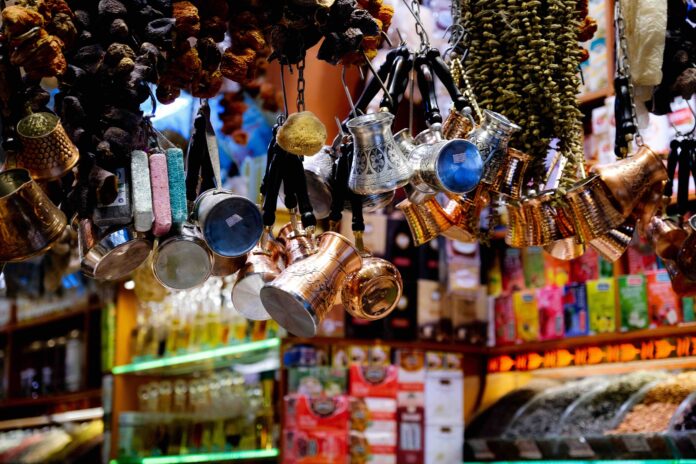The Vibrant World of Spice Bazaar (Egyptian Bazaar)
Istanbul, the city where East meets West, has a lot to offer for tourists. From its rich history to its vibrant culture and cuisine, the city is a treasure trove of experiences. One of the most popular destinations for tourists is the Spice Bazaar, also known as the Egyptian Bazaar.
Located in Eminönü district of Istanbul, this bazaar is a bustling marketplace that has been around since 1664. It was built during the Ottoman Empire to support the nearby New Mosque (Yeni Cami) and provide income for its upkeep.
Today, it continues to attract visitors from all over the world who come to experience its historical significance and cultural importance. The Spice Bazaar takes you on a sensory journey through time, showcasing an array of traditional Turkish products that have been traded for centuries.
From exotic spices to fragrant teas and herbs, from delicious Turkish delight to souvenirs that encapsulate Turkish culture – this bazaar is a feast for all senses. Not only is it an important cultural landmark but also a crucial economic hub where locals and tourists alike can find unique products at reasonable prices.
The Spice Bazaar remains one of Istanbul’s most vital markets in terms of trade and commerce even today. In fact, with over 85 shops lining up its corridors selling everything from spices and herbs to dried fruits & nuts – it attracts more than thousands of visitors per day!
Step by Step Guideline for Spice Bazaar (Egyptian Bazaar)
The Historical Background of the Spice Bazaar
The Spice Bazaar, also known as the Egyptian Bazaar, has a rich history dating back to the Ottoman Empire. It was established in 1664 as a way to provide income for the nearby New Mosque and to support its upkeep.
The bazaar quickly became a hub of activity, with merchants from all over Turkey and beyond coming to sell their wares. Over time, the Spice Bazaar expanded its offerings beyond just spices and herbs.
It became a bustling marketplace for all kinds of goods, including textiles, jewelry, and souvenirs. Despite facing numerous challenges such as fires and earthquakes over the centuries, it has managed to survive and thrive until this day.
Origins during Ottoman Empire
During the Ottoman Empire, Istanbul was known as Constantinople and was one of the world’s most important trading cities. The Spice Bazaar played a crucial role in this trade by providing a central location for merchants to sell their goods. Many of these merchants were from Egypt (hence the name “Egyptian Bazaar”), but others came from far-flung regions like India and China.
The bazaar’s establishment was part of an effort by Ottoman leaders to centralize their control over trade in Istanbul. By creating designated marketplaces like the Spice Bazaar, they could better regulate commerce within their borders.
Supporting Nearby Mosques
One interesting fact about the Spice Bazaar is that it was originally built specifically to support nearby mosques like the New Mosque (also known as Yeni Camii). This was common practice during Ottoman times; marketplaces were often built near mosques not only for practical reasons (such as access to water), but also because they provided a convenient source of income for mosque upkeep. Even today, visitors can see how closely connected these two landmarks are; walking through the arches of the Spice Bazaar, you’ll find yourself facing the impressive facade of the New Mosque.
Architecture and Design
The Unique Design of the Spice Bazaar
The Spice Bazaar, also known as the Egyptian Bazaar, is one of Istanbul’s most iconic landmarks. The bazaar’s architectural design is unique with its domed ceilings and intricate tile work.
The dome-shaped ceiling draws your eyes to the center of the market, creating a central focus for visitors to explore. The tiles used in the bazaar are an intricate blend of blue and white patterns that add to the beauty and elegance of this historic market.
One of the impressive design features that stand out in Spice Bazaar’s architecture is how it was built to keep products cool in hot weather conditions. With temperatures soaring during summer months and in Istanbul’s climate generally being warm, keeping spices fresh was challenging.
To solve this problem, builders cleverly designed a wind tunnel system called “ventilation chimneys” that allowed air to circulate throughout the market naturally. This helped regulate heat and humidity levels, preserving spices’ quality while ensuring customers enjoy a pleasant shopping experience.
Notable Features
Several notable features make Spice Bazaar stand out from other marketplaces. One such feature is how each vendor stall has been located strategically to maximize business visibility while still maintaining respect for other vendors’ spaces. This strategy makes navigation through Spice Bazaar easy for tourists while allowing vendors room to showcase their products without overcrowding.
There are also several historic artifacts on display throughout the bazaar that adds character and charm to its design; some date back centuries ago from when it first opened its doors during Ottoman Empire times. As you navigate through this bustling marketplace, you will notice antique lanterns hanging from ceilings above stalls and vendors calling out greetings as they offer samples or invite shoppers into their stalls.
The vibrant colors of spices displayed are sure to catch your eye as well as an array of Turkish sweets neatly arranged in the stall windows. All of these features combine to create a lively and stimulating atmosphere that makes the Spice Bazaar one of Istanbul’s must-visit locations that is sure to leave a lasting impression.
Products Sold
Aromatic Spices and Herbs
One of the main draws of the Spice Bazaar is its selection of aromatic spices and herbs. Visitors can find anything from cumin, coriander, and cinnamon to more exotic spices like saffron and sumac.
These products are sourced from all over Turkey and beyond, ensuring that visitors get a taste of different culinary traditions. The bazaar also sells a variety of herbs, from mint to thyme to oregano.
These herbs are not just used for cooking but also have medicinal properties. For example, sage tea is known to help with digestion while chamomile tea can help with anxiety.
If you’re not sure what spice or herb to buy, don’t hesitate to ask the friendly shopkeepers for advice. They will be happy to offer suggestions based on your needs or preferences.
Tasty Turkish Delight
Another popular item at the Spice Bazaar is Turkish delight (lokum in Turkish). This sweet treat comes in many flavors such as rosewater, pistachio, hazelnut, pomegranate and more.
The secret ingredient that makes Turkish delight so unique is cornstarch instead of gelatin which also makes it vegetarian-friendly. Turkish delight has a long history dating back centuries in Anatolia region that now includes modern-day Turkey.So when you bite into a piece of this delicious candy you’re experiencing a bit of history as well.
Exotic Teas
The Spice Bazaar is home to an impressive selection of teas from all over Turkey and beyond. You can find traditional black teas such as Rize tea from Northern Turkey or floral ones like rosehip tea which comes from the eastern part of the country. One particularly interesting type is apple tea which has become one of Turkey’s most popular drinks even though it’s not a product of the country.
It is believed that apple tea gained popularity by being served in restaurants and cafes as an alternative to coffee. The Spice Bazaar offers a wide variety of products that are unique to Turkey and the region.
From aromatic spices and herbs to sweet Turkish delight and exotic teas, there is something for everyone. So make sure you leave plenty of time to explore this fascinating market during your visit to Istanbul.
Cultural Significance
The Spice Bazaar is more than just a marketplace; it’s a symbol of Turkey’s rich history and cultural heritage. For centuries, the bazaar has been a gathering place for locals and visitors alike, making it an important center of social activity. People come here not just to buy spices and other goods, but also to socialize and connect with others.
In addition to its social significance, the Spice Bazaar also represents Turkey’s long-standing tradition of trade. The bazaar has served as an important hub for international commerce since its inception, bringing together traders from all over the world to exchange goods and ideas.
This legacy lives on today as visitors wander through the bustling stalls, taking in the sights and sounds of vendors hawking exotic wares from far-flung corners of the globe. The Spice Bazaar also plays an important cultural role in Turkey as a showcase for traditional crafts.
Many of the products sold here are handmade by local artisans using techniques that have been passed down from generation to generation. By supporting these artisans and preserving their craft traditions, visitors are helping to keep alive an important part of Turkey’s cultural heritage.
Conclusion
The Spice Bazaar is truly one of Istanbul’s must-see attractions. Not only does it offer a unique shopping experience for those seeking exotic spices and other goods, but it also provides a window into Turkey’s rich cultural history. Visitors can immerse themselves in centuries-old traditions while enjoying the sights and sounds of this vibrant marketplace.
But beyond its historical significance lies something even more powerful: the sense of community that permeates this ancient bazaar. At its core, the Spice Bazaar represents human connection – whether between locals catching up over tea or between travelers from different parts of the world discovering new flavors together.
So as you weave your way through the Spice Bazaar’s labyrinthine passages, take a moment to appreciate the cultural significance of this treasured landmark. Because in doing so, you’re not just experiencing a market – you’re experiencing humanity at its best.



